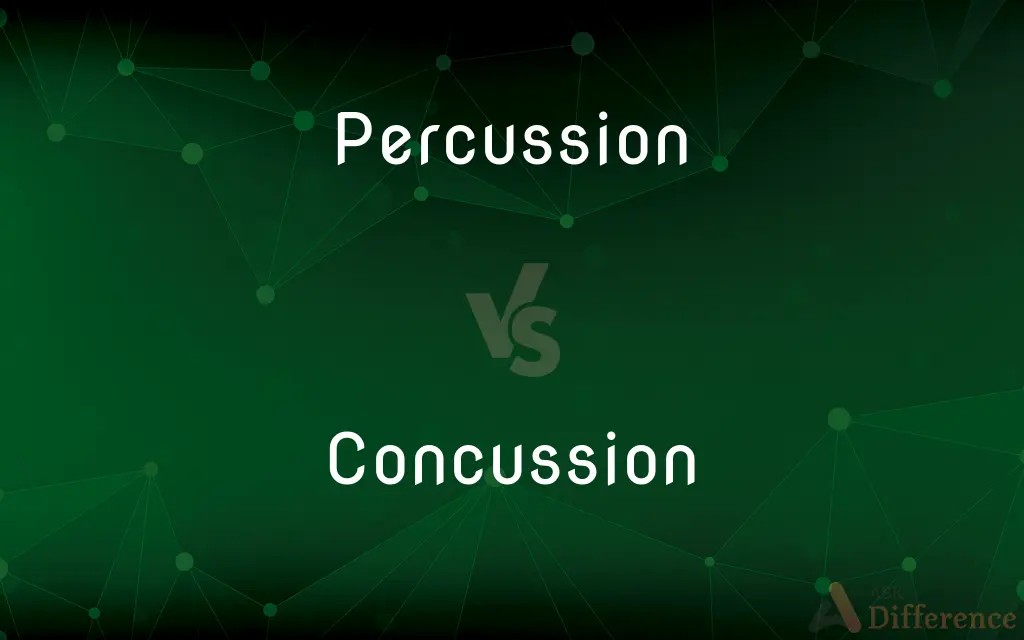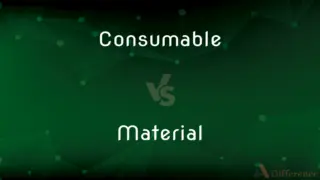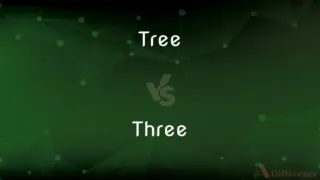Percussion vs. Concussion — What's the Difference?
By Fiza Rafique & Urooj Arif — Updated on March 1, 2024
Percussion is a musical term referring to instruments that produce sound through being struck, while concussion is a medical condition resulting from a blow to the head, affecting brain function.

Difference Between Percussion and Concussion
Table of Contents
ADVERTISEMENT
Key Differences
Percussion instruments, such as drums and cymbals, rely on the physical action of being hit, shaken, or scraped to generate sound, emphasizing rhythm in music. Concussion, on the other hand, involves the brain being jolted inside the skull due to a direct or indirect impact, leading to temporary cognitive, physical, and emotional symptoms.
The essence of percussion in music lies in its variety and ability to produce a wide range of sounds, from the deep booms of bass drums to the sharp clatter of snare drums, forming the backbone of rhythm in many genres. Concussions are characterized by a spectrum of symptoms including headache, confusion, dizziness, and in some cases, loss of consciousness, with the severity and duration varying from person to person.
Percussion instruments are foundational in orchestras, bands, and solo performances, serving both melodic and rhythmic roles, and are celebrated for their cultural and historical significance across the globe. Concussions require medical attention to assess and manage the injury, with treatment often involving rest and gradual return to normal activities, highlighting the importance of understanding and preventing head injuries.
Percussion brings vibrancy and dynamic layers to music, engaging listeners and performers alike, concussions pose serious health risks, necessitating awareness and caution in physical activities to protect brain health. This contrast underscores the diverse implications of physical impact, from artistic expression to health challenges.
Comparison Chart
Definition
Group of musical instruments played by striking, shaking, or scraping.
A medical condition caused by a blow to the head, affecting brain function.
ADVERTISEMENT
Primary Context
Music
Medicine
Function/Role
To produce rhythm and melody in music.
Results in temporary impairment of brain functions.
Examples
Drums, cymbals, xylophones.
Symptoms include headaches, confusion, dizziness.
Outcome/Effect
Creation of sound and rhythm.
Potential cognitive, physical, and emotional symptoms.
Compare with Definitions
Percussion
Can be tuned (like timpani) or untuned (like snare drums).
The timpani brought a dramatic, tuned percussion sound to the performance.
Concussion
A brain injury caused by a blow to the head or body, leading to temporary dysfunction.
After falling, she was diagnosed with a mild concussion.
Percussion
Includes instruments like drums, tambourines, and maracas.
He played the tambourine, a simple percussion instrument, with enthusiasm.
Concussion
Symptoms may include headache, confusion, and memory loss.
He experienced severe headaches and confusion, indicating a concussion.
Percussion
Musical instruments that produce sound when struck, shaken, or scraped.
The percussion section of the orchestra added a thrilling rhythm.
Concussion
Awareness and prevention are key to managing concussion risks.
The school implemented new protocols to better manage and prevent concussions.
Percussion
Vital for keeping rhythm in bands and orchestras.
The drummer's percussion skills energized the entire band.
Concussion
Can occur in sports, accidents, or any activity involving impact.
Wearing helmets is crucial to prevent concussions during football games.
Percussion
Engages audience through dynamic and rhythmic sound production.
The concert's percussion solo captivated everyone with its complexity.
Concussion
Requires medical evaluation and often rest for recovery.
The doctor recommended two weeks of rest to recover from the concussion.
Percussion
The sound, vibration, or shock caused by the striking together of two bodies.
Concussion
A concussion, also known as a mild traumatic brain injury (mTBI), is a head injury that temporarily affects brain functioning. Symptoms may include loss of consciousness (LOC); memory loss; headaches; difficulty with thinking, concentration or balance; nausea; blurred vision; sleep disturbances; and mood changes.
Percussion
The act of detonating a percussion cap in a firearm.
Concussion
A violent collision or shock.
Percussion
A method of medical diagnosis in which various areas of the body, especially the chest, back, and abdomen, are tapped to determine by resonance the condition of internal organs.
Concussion
A shaking or agitation; a shock; caused by the collision of two bodies.
It is believed that great ringing of bells, in populous cities, hath dissipated pestilent air; which may be from the concussion of the air.
Percussion
The act of percussing, or striking one body against another; forcible collision, esp. such as gives a sound or report.
Concussion
A condition of lowered functional activity, without visible structural change, produced in an organ by a shock, as by fall or blow; as, a concussion of the brain.
Percussion
The act of tapping or striking the surface of the body in order to learn the condition of the parts beneath by the sound emitted or the sensation imparted to the fingers. Percussion is said to be immediate if the blow is directly upon the body; if some interventing substance, as a pleximeter, is, used, it is called mediate.
Concussion
The unlawful forcing of another by threats of violence to yield up something of value.
Then concussion, rapine, pilleries,Their catalogue of accusations fill.
Concussion
Any violent blow
Common Curiosities
What is the primary difference between percussion and concussion?
Percussion refers to a category of musical instruments played by striking, while concussion is a type of brain injury.
How long does it take to recover from a concussion?
Recovery times vary, ranging from days to weeks, depending on the severity of the concussion.
Do percussionists need special training?
Yes, mastering percussion instruments often requires specific training to develop rhythm, technique, and musicality.
Can concussions be prevented in music performances?
While concussions are unrelated to music performances, safety in physical activities associated with performances can minimize risks.
What are the long-term effects of concussions?
Repeated concussions can lead to long-term neurological issues, emphasizing the need for proper treatment and prevention strategies.
Is there a concussion risk in playing percussion instruments?
The risk of concussion from playing percussion instruments is minimal, focusing more on hearing protection due to volume.
Can electronic devices simulate percussion instruments?
Yes, electronic devices can mimic the sounds of percussion instruments, offering versatility in music production.
What should you do if you suspect a concussion?
Seek medical attention immediately for an evaluation and appropriate care.
Can percussion instruments be part of therapy?
Yes, percussion instruments are used in music therapy to aid in emotional expression and motor skill development.
How does culture influence percussion music?
Different cultures have unique percussion instruments and rhythms, reflecting their historical and social contexts.
Are all percussion instruments loud?
Not necessarily; the volume of percussion instruments can vary widely from soft chimes to loud drums.
How are concussions diagnosed?
Concussions are diagnosed through clinical evaluation and, if necessary, imaging tests to assess brain function.
Can concussions occur without a direct hit to the head?
Yes, concussions can happen from any impact that causes the brain to move rapidly inside the skull.
Are there any silent percussion instruments?
While all percussion instruments produce sound, some electronic percussion pads can be used with headphones for silent practice.
What role does percussion play in a band?
Percussion is crucial for maintaining rhythm and adding dynamic layers to the music.
Share Your Discovery

Previous Comparison
Consumable vs. Material
Next Comparison
Tree vs. ThreeAuthor Spotlight
Written by
Fiza RafiqueFiza Rafique is a skilled content writer at AskDifference.com, where she meticulously refines and enhances written pieces. Drawing from her vast editorial expertise, Fiza ensures clarity, accuracy, and precision in every article. Passionate about language, she continually seeks to elevate the quality of content for readers worldwide.
Co-written by
Urooj ArifUrooj is a skilled content writer at Ask Difference, known for her exceptional ability to simplify complex topics into engaging and informative content. With a passion for research and a flair for clear, concise writing, she consistently delivers articles that resonate with our diverse audience.
















































